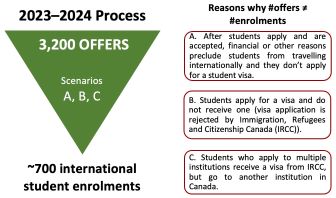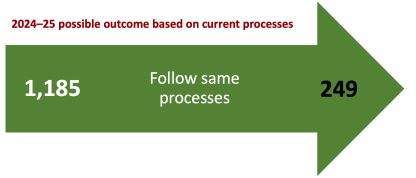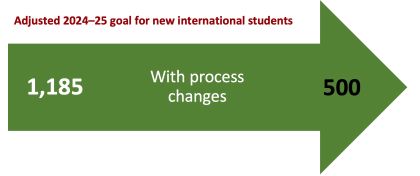Message from the Interim President: The federal government’s cap on international students

The following message has been distributed to students, staff, and faculty by UPEI Communications on behalf of the Office of the President.
Dear Members of the Campus Community,
The processes and implications of the new federal government cap on international students are very complex and, in some cases, still quite uncertain more than six weeks after it was first announced. Below is a list of key issues and a more detailed analysis of what the challenges are for UPEI.
Key issues
On January 22, 2024, the federal government announced that they were putting restrictions in place to reduce the number of new international undergraduate students entering Canada by 35 per cent (see below for more details on which UPEI student groups are affected).
- The rules apply to new undergraduate students. Those with existing study visas are not impacted while completing their programs.
- In 2023–24, UPEI made about 3,200 offers to international undergraduate students and welcomed slightly over 700 new undergraduate and Doctor of Veterinary Medicine students.
- On March 7, 2024, the province announced that UPEI would be allocated 1,185 “attestation letters” or offers leading to visa applications based on a federal allocation of 2,000 “attestation letters” to the province.
- The federal allocation was expected to be based on population; however, the allocation appears to be 30 per cent less than the provincial population would dictate.
- Visa approvals vary by country of origin and are overall on average 60 per cent. Some countries, which have become important recruitment locations for prospective UPEI students are far below this average.
- Factors, such as student financial circumstances and students accepting competitive offers from other institutions, mean that conversion rates from an acceptable application to actual arrival at UPEI are far below the 60 per cent the allocation appears to be designed around.
- Using past conversion rates at UPEI, 1,185 offers would be expected to result in 249 new students (down from 700). Staff are working on processes to improve conversion rates and to ensure that students who receive offers are very serious about coming to UPEI.
- Within our planning, our initial aim is to cushion the impact somewhat for 2024–25; however, the effects of this policy are anticipated to be felt for many years to come.
Current understanding of international student application and visa process change implications
The following is based on our current understanding of the federal program to limit new international student visas:
- The new restrictions on international student visas (announced January 22, 2024) impacts incoming (new) international students in all undergraduate programs. For purposes of student visas, Doctor of Veterinary Medicine (DVM), postgraduate certificates in veterinary medicine (interns), and BEd students (despite requiring a previous undergraduate degree) are considered undergraduate. Only students in master's and doctoral (PhD, PsyD) programs do not count towards the visa cap.
- In the Fall semester 2023, UPEI had 1,995 international students (graduate and undergraduate) out of a total student population of 5,816 students. During the academic year 2023–24, UPEI welcomed slightly more than 700 new international students to our undergraduate and DVM programs. Students come to UPEI from more than 90 countries with the top five being Nigeria (395), India (298), China (166), the United States (131), and Nepal (114).
The 2023–24 process
To achieve the number of 700 new international student enrollments in 2023–24, UPEI made offers to 3,200 students.

Offers are not converted into actual enrolment of students in classes for a number of reasons, including:
- After students apply and are accepted, financial or other reasons preclude them from travelling internationally for their education, and they don’t apply for a student visa.
- Students apply for a visa and do not receive one (visa application is rejected by Immigration, Refugees and Citizenship Canada (IRCC)).
- Students who apply to multiple institutions receive a visa from IRCC but go to another institution in Canada.
Provincial caps
On March 7, 2024, the province announced that IRCC had allocated 2,000 provincial attestation letters (PAL) to PEI and that, in turn, the province was allocating 1,185 of those to UPEI. In calculating the number of attestation letters for PEI, IRCC appears to only have considered scenario (B) above; that is, “on average,” 60 per cent of students who apply for a visa receive one.
There are two serious flaws in this approach. First, it ignores scenarios (A) and (C). Once issued, a student visa is not institution- or province-specific. Students can use a PEI-attestation-generated visa anywhere in Canada. Therefore, item (C) (getting a visa and going to another institution) disadvantages PEI because we have only one English language public university and one English language public college. By contrast, if Ontario uses an attestation letter, students have the choice of dozens of public universities and colleges, leading to much less risk that those students will attend a college or university outside the province.
The second serious flaw is that success in visa acceptance rates for Atlantic universities is below the national average. It is very unlikely that, even if there is zero attrition based on scenarios (A) and (C) above (a totally unrealistic expectation), UPEI will be able to convert 1,185 attestation letters into previous year’s numbers (700). For example, the proportion of students attaining a visa from Nigeria was 17, 18, and 34 per cent, for 2019, 2020, and 2021, respectively (the last years from which data is available)1. Nigeria is the country of origin of our largest student population, representing 19 per cent of our international students.
Finally, there are other serious questions regarding the allocation of attestation quotas to PEI. The stated goal of the federal initiative is to reduce international student numbers to 364,000 from last year’s total of 560,000 (a 35 per cent drop). Based on this, and IRCC’s average of 60 per cent conversion from visa application to approval, there should be 606,000 attestation letters available to the provinces.
When the program was announced, it was indicated that these would be given out in proportion to provincial population. If this were the case, with 0.043% of the national population, PEI should have received 2,631 attestation letters—30 per cent more than the province actually received. Data is emerging that other Maritime provinces are receiving similarly reduced allocations, while it appears that Ontario and British Columbia are receiving 100 per cent of their allocation. The explanation for this is unclear.
What does all this mean for UPEI in 2024–25
If we had the same processes and conversion of offers to students in classes, 1,185 attestations would result in a decrease of new undergraduate international students from 700 to 249.

UPEI staff, particularly those with the Office of the Vice-President Academic and Research (e.g., in international recruitment, the Registrar’s office, and institutional research), are making best efforts to identify and control the variables we can. We are examining all our processes to ensure that those to whom the province is extending attestation letters are very serious about coming to UPEI. We cannot influence IRCC’s student visa approval rate; however, on March 7, 2024, after much work by our provincial government colleagues, provinces were given the ability to set an expiry date on attestation letters and reuse those that did not result in a visa application. This goes some way to addressing item (A); however, by the time these recycled attestation letters become available, students may have accepted offers at other institutions. Our goal, with our process changes, will be to try to double our conversion of offers to new students in the classroom from the projected 249 to 500.

Impact on UPEI sustainability
Other provinces have recognized that the cap may have a highly significant impact on university and college sustainability. Recently, Ontario set aside $200 million for “institutions in greatest need,” which has been interpreted as those most impacted by the international visa cap2. Because our number of students in year four (expected to graduate) is quite a bit less than the current number of year one students, if we retain a high proportion of current students, going from the number of 2023–24 new students to our goal of 500 may not result in an overall reduction in student numbers. This cushions UPEI in 2024–25. The influence of the cap will however be felt quite substantially in future years if the number of incoming students eventually does not mirror the number of students leaving through graduation or attrition. This is structured as a two-year program, but the impacts could be felt for many more years.
The UPEI approach moving forward
UPEI will continue to work with the province for a fair allocation of attestation letters to PEI recognizing both our population and the disparity in visa approval proportion. Our team will continue to work to control scenarios (A) and (C), as much as we possibly can, to ensure prudent use of our limited attestation letters. We ask for your continued support as we do so.
Regards,
Greg
GREG KEEFE, DVM, MSc, MBA (he/him)
President and Vice-Chancellor (Interim)
University of Prince Edward Island
1 https://www.canada.ca/en/immigration-refugees-citizenship/corporate/transparency/committees/cimm-feb-15-17-2022/student-approval-rates.html#wb-auto-7 (accessed March 10, 2024)
2 https://higheredstrategy.com/the-ontario-funding-announcement/ (accessed March 10, 2024)